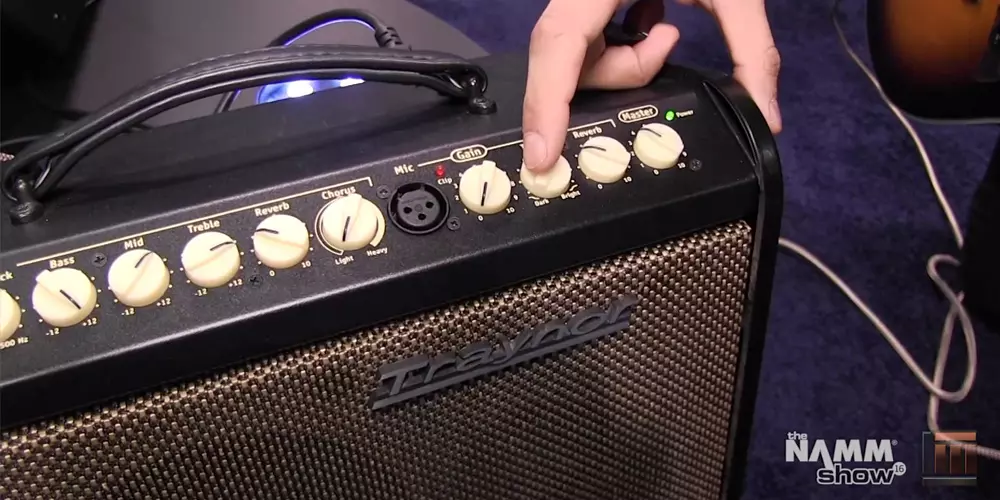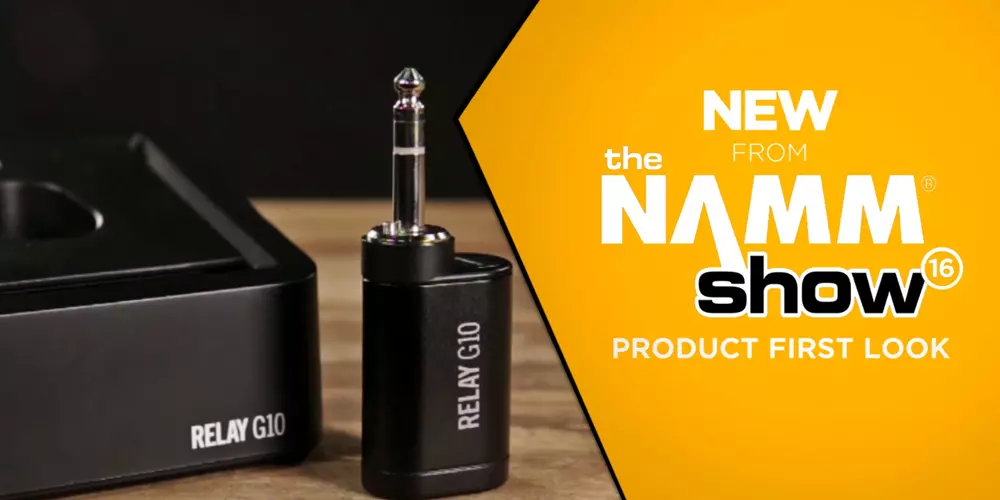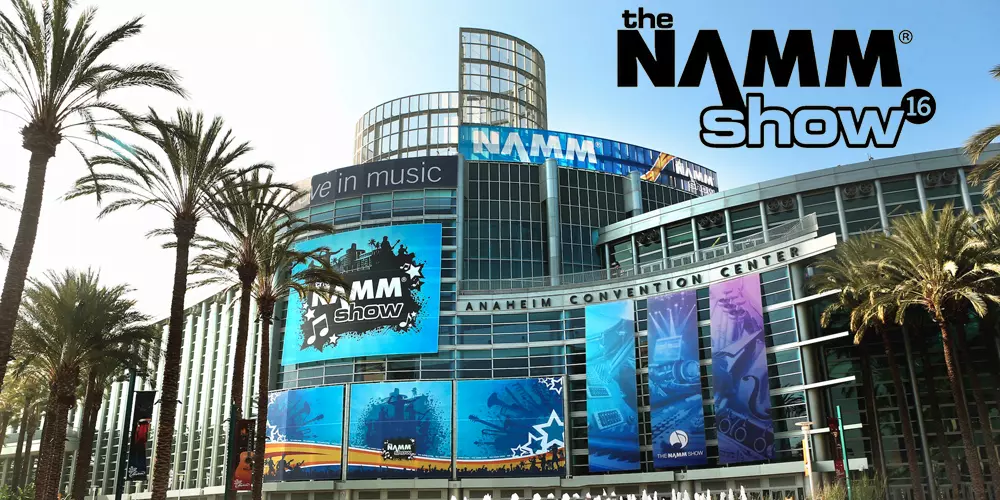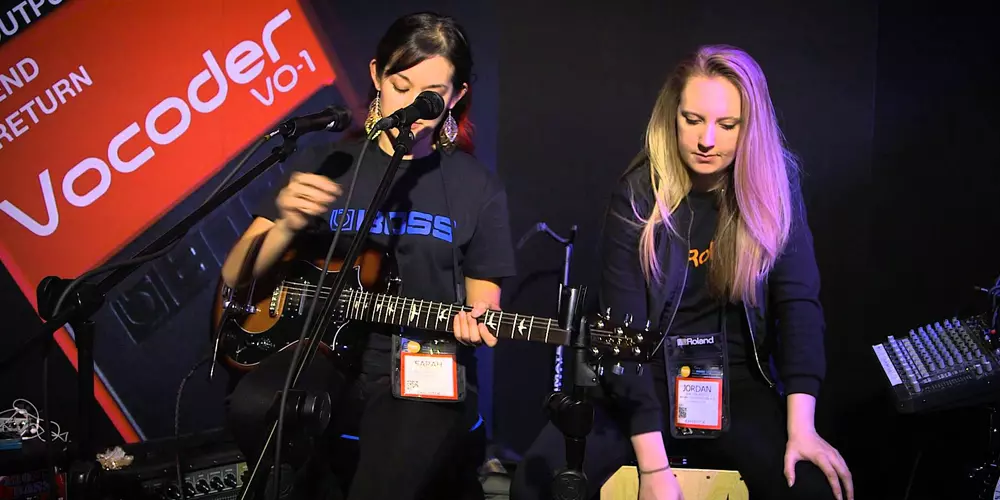NAMM 2016: New Guitar, Bass, and Drum Amps for Stage, Studio, and Home

Traynor Acoustic Master Mini Amp (AM Mini)
TEXT OF VIDEO:
Hey, Steve Das from Traynor Amps here at NAMM 2016, here to show you the brand new Acoustic Master Mini Amp.
The AM Mini is a two channel, 65 watt acoustic amp featuring a six and half inch woofer and a soft dome tweeter. The first input for your guitar features a gain control, an anti-feedback notch control, bass, middle, treble EQ controls and we've also included reverb and chorus effects.
The second channel for your vocal mic features an XLR input, gain control. We've also included a tone control, if you wanted to add some more bottom end or brightness, and we've also thrown in some reverb effects as well.
The AM Mini is perfect for smaller gigs, coffee shops, things like that, but if you needed to score a bigger gig, we actually included a direct out in the back, so plug that in straight to the front of the house and now you can use the AM Mini as your own personal monitor.
We've also included an auxiliary input, so if you want to plug in your tablet or smartphone and jam along with your tracks, you can do that as well.
The AM Mini is projected to be available June, July, Summer 2016 … new from Traynor Amps.
More information can be found at www.traynoramps.com. Thanks a lot, Long & McQuade. We'll see you soon.
Traynor DW10 Drum Amp
TEXT OF VIDEO:
How are you doing? Steve Dass from Traynor here at NAMM 2016. Here to show you the brand new drum amp from Traynor.
The DW10 is a three channel, 200 watt amp. Featuring a 10 inch woofer and a 1 inch driver. Each channel has stereo cords and jacks input, and on your second and third channels you have the option to send or bypass the EQ and direct out.
Simple bass, middle treble controls and a master volume control.
On the back of the unit. This is where you will find your stereo cords and jacks inputs for each three channels. On the third channel we've also included a quarter inch auxiliary channel. Stereo DI out in the back and that is a feed the board.
The brand new DW10, from Traynor. Expect it to be shipping some time around June or July 2016.
Line 6 Firehawk 1500
TEXT OF VIDEO:
Hey, what's going on, guys? It's Victor Moncebaiz here with Line 6. We're hanging out at NAMM 2016 with the guys at Long & McQuade. We're going to take you guys through our new product launches this year.
We're going to start right here with the Firehawk 1500, sitting right behind me. This is a 1500 watt stage amp, and by stage amp, what we mean is it looks like a traditional amp but it's got a lot more going on under the hood. Besides just having a giant 1500 watt power amp section, we've also built in a six-way speaker system. You've got your traditional guitar, its driver right in the middle, joined by a high frequency driver, two coaxial speakers on the side. That's actually going to work out really well when you start adding in all the effects that are housed inside the box, so things like reverbs and delays. You can get this big stereo image happening.
Again, on the top of this, if you want to take a look, we've got our traditional amp control, so things like drive, EQ and overall level, but there's a lot more going on like I was saying. To get access to a lot of that stuff, we're going to take advantage of Firehawk remote app. If you guys have or have not seen this, if you take a look over here, it's essentially your entire signal chain represented. All this DSP is housed in the amp itself, so you don't need anything external to work with it. It'll help you set up and quickly edit all of your tones. Hundreds of effects in here. Different amp types, different cabinet types, different microphone models, all within the box. You do it on your smart device.
Again, on the back of this, we also have some pretty extensive i/o. Being that it is a massive system here, we can use it for things like keyboards, basses and the fact that it's a six-way speaker system, it's much more full range, flat response system. It'll work out really well for other instruments, acoustics, bass guitars, keyboards, things like that.
As you can hear, we've got a pretty nice clean sound. One of the big advantages of having 1500 watts in the stage amp is that we can really use the volume to our advantage. We can crank up this amp without that clean sound distorting and breaking up the way it might on a traditional amp. Conversely, if we had something that had a lot more gain, we don't need it to be cranked up to sound good. We can get really, really usable gain and saturation levels at lower volume.
Cool. Again, it's super, super versatile in its uses. We've got 1500 watts of headroom to work with. Notice here I'm stepping down here on a controller for it, which is an optional accessory. This is the FBV3, also being launched here at NAMM 2016. It's essentially what you might expect from the Firehawk. It's color-coded, so we have things like all the yellow rings are set up to be gain-based effects. The blues are the modulations. Greens for delays. Oranges for reverbs. One of the other big advantages, too, for doing things like reverbs and delays, things that normally might have a stereo image, when we're doing the Firehawk 1500, those effects are actually carried in full stereo since we have a six-way speaker system. You get this really, really nice stereo image coming from one compact box.
That's essentially the Firehawk 1500 in a nutshell. Thank you guys.
Fender Bassbreaker Amps
TEXT OF VIDEO:
Hi, Shane from Fender here at the NAMM Show 2016. This is the new Fender Bassbreaker Series of amplifiers. These are guitar amps that kind of hark and back to the tradition of the original '59 Fender Bassman which you may know a lot of companies kind of took that circuit and moved on and did other things with it. We're kind of taking it back for Fender.
We have a range of combos and heads from 45 watts down to 7 watts. They're very modestly priced, made in our Ensenada, Mexico facility. The 45 is a true recreation of the '59 Bassman circuit with a couple of minor changes for today's player. One being there's an output level knob that goes from 45 watts all the way down to 1 watt, so you can get that really nice juicy output tube distortion and dynamics at a lower volume so that your band mates aren't mad at you. That's the 45.
We're going to go all the way back to the smallest guy in the series, the 7, "007" we call it. It's the 7 watt, available in a combo or a head. The 007 is a very different amplifier, it's a single-ended, singled power tube EL 84, which is Class A, and so you get some nice juicy harmonics. Again, you turn your guitar down, single coil, so this is a fantastic amp for the bedroom, for the recording situation, 7 watts in a head or a combo. I'm playing it right now through a single 12 enclosure, and the entire Bassbreaker Series, although 4 of them have very different kind of things that they do, they all benefit from a semi-closed back cabinet construction.
What makes that cool, is Fender amps traditionally are open-backed and you get lots of air around the amp and it's ambient in the room. Close-back amps give you that thumping, tight-bottom end, but then it doesn't have the air around it. A semi-closed back blends the two approaches where you get some of that punch and some of the air around the amp. We really think it's a neat addition to this line.
Moving on from the 007, which is the nice little high-gain amp, we're going to switch over to the 15. 15 has kind of a new thing for us at Fender, a 3 position gain structure switch. This is almost like a boutique-amp feature, where I can have a very clean tone. I can go to a second gain level, that's a different tone shape. Then up to a real high-gain option. Lots of high-gain stuff in there. The 15 watt Bassbreaker is the only one that has reverb in it. We've gone with a digital reverb, meaning if you like a Fender spring reverb, we make about 60 amps that have that. If you're a high-gain player, the digital actually doesn't get in the way as much and works really well. That's the Bassbreaker 15.
Then moving on to the 1830. The 1830 is kind of a club master where you have a 30 watt channel, with the tonality of a deluxe reverb, and an 18 watt channel with the tonality of a Fender 1961 brown deluxe, which is an interesting transitional amp that was kind of similar to the tweed deluxe and was used on a lot of recordings over the years. My 18 watt channel, excuse me, my 30 watt channel rather, kind of a nice spanky twang. Switch over to the 18 watt, it's not like you went to a completely different amplifier, you just went to an amplifier with less headroom. All those cranked up tones are there at the 18 watt side, but you still can go back on the same amp. It's not switching a preamp. We have amps like the Supersonic or the Hotrod where you're switching the preamp. This is literally changing the output level of the power amp, so you're getting power amp distortion at a lower level on the 18 watt.
That's the new Bassbreaker Series of amps from Fender. I'm Shane signing out, thank you.
Fender "The Edge" Deluxe Amp
TEXT OF VIDEO:
Hi, everybody. Shane from Fender here with the new Edge Deluxe. The Edge Deluxe is based on the famous narrow panel Fender Tweed Deluxe. It's an all hand wired circuit. People of all walks of life love this amp and collect them and enjoy them. We've been working with The Edge from U2 for a number of years now. He's been playing old Tweed Deluxes for about 15 years, and in the last three years, we've started making some prototype amps for him. This is the culmination of that.
The differences from this amp with the regular re-issue 57 Deluxe is you have a slightly different volume taper, where from one to three, there's a smooth transition, where you go from clean to dirty. These amps get dirty really quick. That's a nice feature.
The phase inverter's tightening up the bass a little bit, so it's not as sloppy as a normal Tweed Deluxe would be. The really big change sonically is we have an Alnico Celestion Blue in here, which is The Edge's preferred speaker.
Of course, you can use this to play U2 type stuff, as The Edge does on tour and in the studio. There's all kinds of tones in here, though. If you play blues or country or whatever you do, use your dirt pedals with it, or just play it nice and clean, one of the most touch sensitive amps ever is the Tweed Deluxe.
That's the Edge Deluxe brand new from Fender here at the NAMM show.
Hughes & Kettner TubeMeister Deluxe
A walkthrough and demonstration of the Hughes & Kettner TubeMeister Deluxe at NAMM – the guitar was recorded using the on-board Redbox output.
TEXT OF VIDEO:
Hello, my name is Lawrence Bell coming to you from the 2016 Winter NAMM Show here in Anaheim, California. We've got some really new, exciting products from Hughes and Kettner that we want to show to you. Let's talk about the new Tubemeister Deluxe Series amplifiers. These amplifiers are completely deluxe. You've got deluxe tones, deluxe features over the old series of Meisters. You can visually see some differences here, we've taken away the chrome panel, everything is black. Really sleek looking on the front. Even when the amp is turned off, you've got a blue shielded tube in the front of the amplifier to still give it that signature blue look.
As you can probably imagine, there are some really killer new features on this amplifier in terms of flexibility for recording at home, playing on stage, or even practicing quietly at home in your bedroom. I'm going to turn it over to Dennis Shepherd, he's our product specialist. Dennis, what do you think about this new amp?
The new amp is great. We've completely redesigned the preamp section, so we now have a cathode follower to give more gain and more dynamics on it, especially on the clean channel. As well as on the crunch and lead channels. That's a big difference on these new models.
We also have a brand new Redbox AE. Both of these concepts were taken from the Triamp Mark 3, so we've got kind of a brown sound for the crunch channel, and all of their tones take the lead from Triamp Mark 3. The Redbox AE does as well. This is our Redbox ambiance enhanced. We actually have some impulse response processing in there to give you the room sound and the sound of a real mic'ed speaker in a room.
Some new features on here besides that, we now have in addition to the vintage and modern voicing, and the small and large cabinet 112, 412, we now have a line and a mic level signal. In the past, the old Tubemeisters, they were just line level. People had some concerns that it was a really hot signal and you kind of had to tailor your input gain to really make it work. Now, we have that mic level so you can tailor it to your system and make it give out the signal that you want.
We also have a full-range flat response here. You can turn all of the circuitry of the Redbox off and still get a tube-driven sound to use with plugins. You can record and as we have the amp currently plugged directly into the recorder over here, we can maybe flick that switch and show you what it sounds like. It sounds terrible by itself, but it's designed for guys who want to use plugins and want to have a tube signal going in. Pretty exciting new Redbox, I think you'll find that really sounds great, more like a mic'ed cabinet than ever.
Roland Blues Cube
TEXT OF VIDEO:
Hey, guys. It's Alex Hutchings here at the Winter NAMM 2016. I'm going to be showing you the Blues Cube here. We've got the Ultimate Blues Tone Capsule, and we've got the Blues Cube Hot, and yeah I'm just going to quickly run you through. We've got the clean channel that I can boost, we've got a crunch channel that I can boost … t’s really responsive, real smooth, so I'm just going to very quickly jam and you can hear each part. Here we go. First, the clean channel sounds a bit like this.
I'm going to add some boost to that.
Okay, let's go to the crunch here. I'll add a little more boost to that channel as well.
Now I'll use the jewel tune, the clean and the crunch together.
Okay, hopefully you get the idea. It's really responsive. If I play softly, it's real warm. If I really dig in, really feels great and sounds good too, so let's go over and have a look at the Blues Hot.
All right, here's the Blues Hot. 30 watts, single channel with a switchboard boost. With a boost as well. Sounds great. We had to keep it short I'm afraid, but yeah. Go and check it out and I think you'll find that it feels really good and sounds great too.






